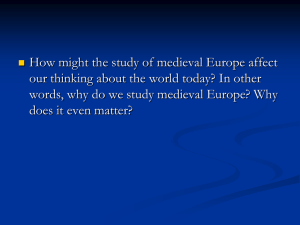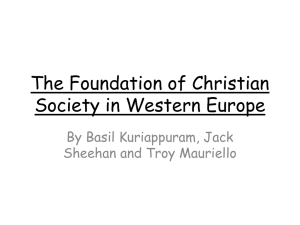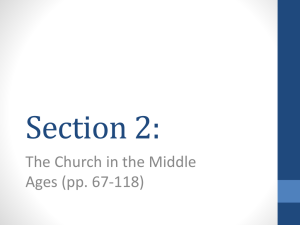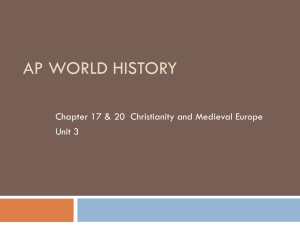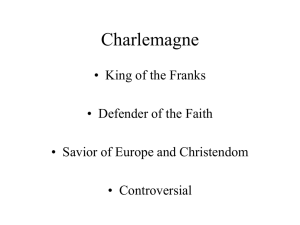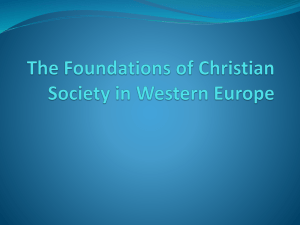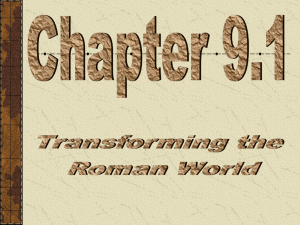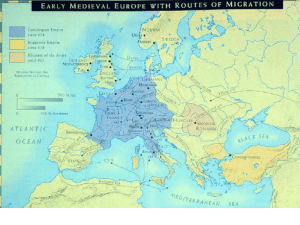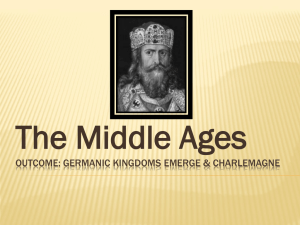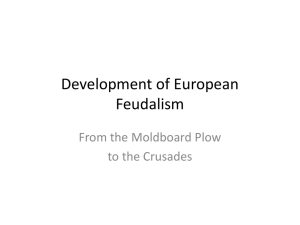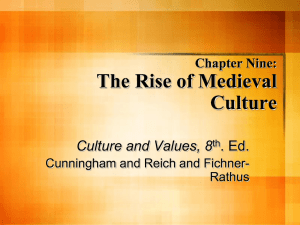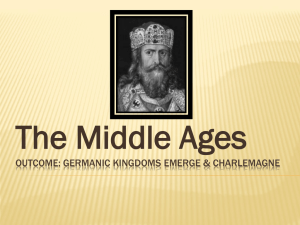Chapter 18 The Franks - Dalton Local Schools
advertisement
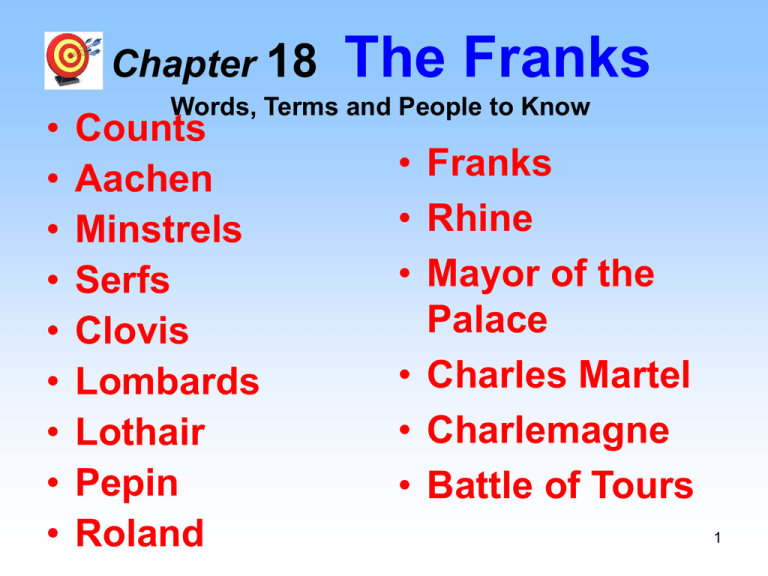
Chapter 18 • • • • • • • • • The Franks Words, Terms and People to Know Counts Aachen Minstrels Serfs Clovis Lombards Lothair Pepin Roland • Franks • Rhine • Mayor of the Palace • Charles Martel • Charlemagne • Battle of Tours 1 Chapter 18 The Franks Goal during the Early Middle Ages was to revive the stability and safety of the Roman Empire Germanic stress upon personal ties made it impossible to establish orderly government over large areas during much of the Middle Ages Simply put--Germanic people were unable to conceive of the kingdom as anything other than a 2 private estate • Germanic peoples showed no sense of political responsibility and tended to divide and subdivide their lands among their heirs. • Relied upon violence to define their powers. • A history of their reigns is largely a dismal story of destructive feuds and intrigues. 3 Chapter 18 The Franks The “Ballpark Franks”—distant cousins • Feudalism and • Transitions Describe the conditions that gave rise to feudalism, as well as political, economic and social characteristics of feudalism, in Asia and Europe. Explain the lasting effects of military conquests during the • Middle Ages including: Equestrian statuette of Charlemagne or Charles the Bald The monarch, holding a globe and a sword (now missing), asserts his authority as a conqueror. – a. Muslim conquests; – b. The Crusades; – c. The Mongol invasions. 4 What we’re about to study. 5 6 • • • • • Section One: discusses the goals of Clovis and the role of the Catholic Church in political affairs of the Franks Terms to Learn: Converted “ At that time many churches were plundered by the troops of Clovis, for he still held fast to his pagan idolatries. The soldiers had stolen an ewer of great size and wonderous workmanship,…” http://www.learn360.com/ShowVideo.aspx?ID=231043 The Franks 46 min. Terms to Learn: anointed People to Know: Clovis I. Clovis Clovis Changes the Path of the Franks video 4:17 Gregory of Tours’ History of the Franks – A. Germanic Franks build civilization that develops into modern-day France and Germany B. Initially divided into many kingdoms until 481 A.D. – Battle of Tolbiac. Clovis defeats the Alammani (Paris) by circa 1881. – C. in 481 chose Clovis as king. Clotilda was an orthodox Christian • 1. Clovis brings all Franks into one kingdom. Wife • 2. Run Time: [03:59] Sigobert and Clovis are victorious after Clovis prays to the Christian God, which lead to the religious conversion of the Franks First Germanic king to accept Catholicism – (a.) Clovis and 3000 soldiers convert, becomes the first Germanic king to become an orthodox Christian. 7 I. Continued – D. gains support of Romans in his kingdom – E. begins speaking a form of Latin called French • 1. all people in kingdom now unified by language, religion – F. Pope and the church gave Clovis their support and in return Clovis protected the Church against nonbelievers – G. Extended rule over France and western Germany and set his capital in Paris 8 A hereditary monarchy is the most common style of monarchy and is the form that is used by almost all of the world's existing monarchies. Under a hereditary monarchy, all the monarchs come from the same family, and the crown is passed down from one member to another member of the family. The hereditary system has the advantages of stability, continuity and predictability, as well as the internal stabilizing factors of family affection and loyalty. Pippin III, gathered support among Frankish nobles for a change in dynasty. When the Pope appealed to him for assistance against the Lombards, Pipin insisted that the church sanction his coronation in exchange. In 751, Childeric III, the last Merovingian, was deposed. Pepin was elected King of the Franks by an assembly of the Frankish leading-men and anointed at Soissons, perhaps by Boniface Childeric was allowed to live, but his long hair was cut and he was sent to a monastery. 9 Section Two: describes the rule of Charles Martel and the Battle of Tours • • • People to Know: Charles Martel People to Know: Pepin People to Know: Charlemagne II. Charles the Hammer • A. Clovis’ heirs divided the kingdom and fought over their shares • B. Heirs lost power to local nobles • C. Franks accept leadership of the Mayor of the Palace • D. Mayors take over many of the king’s duties • E. Charles Martel most powerful of the mayors • F. Charles becomes known as “The Hammer” because of his strength in battle http://www.learn360.com/ShowVideo.aspx?ID=348388 The Franks and Moors 8:00 min • G. Led Franks to victory over the Muslims at the Battle of Tours in 732 which protected 10 Europe from the spread of Islam. The Franks unflinchingly received the Moslem charge, fending it off. The Arabs attacked repeatedly, searching Aftermath for a weakness in the Franks' line. But the Frankish Army was like a wall against which the Arabs quickly pounded While exact casualties themselves to pieces. for the Battle of Tours are not known, some chronicles relate that Christian losses numbered around 1,500 while Abdul Rahman suffered As Arab stamina faded, the Franks counterattacked. The approximately 10,000. Since Martel's victory, historians Arabargued flank was turned by a vengeful Eudo and his some men have over the battle's significance with from Aquitaine. Abd-ar-Rahman was killed while trying to stating that his victory saved Western rally his broken army. Next morning the Franks Christendom while others feel that its repercussions discovered the Moslem camp deserted except for were minimal. Regardless, the Frankish victory at abandoned plunder and the Arab dead. Tours, along with subsequent campaigns in 736 and Charles earned his name "The Hammer," and France 739, effectively stopped the advance of Muslim forces never againallowing was invaded a Moslem Army. Although from Iberia the by further development of the the Arabsstates were only raiding, Europe a Frankish defeat at Tours Christian in Western would have led to greater incursions. As it happened, Abdar-Rahman's death brought on a revolt by the 13 Berbers which destroyed Arab unity. In November 751 at Soissons, Pepin the Short was anointed as king by Archbishop Boniface. The timing was perfect. The papacy was in dire straits because of the Lombards who were constantly Places to Locate: Paris door and trying to kick butt. The pope needed Pepin. knocking on Rome's II. Continued • • • Places to Locate: Tours And Pepin wasAachen just the man for the job. Places to Locate: But life was tough and on the way home from one of his campaigns in Aquitaine he – H. When Charles died his son Pepin (Pepin simply died. became Mayor of the Palace – I.theWith thewent helpto of the Pope Pepin So kingdom Pepin's sons, Charles (Charlemagne) and king Carloman. removed the and was anointed the first Frankish king anointed by the pope Brother Carloman had already died in 754 and half brother Grifo had III, Pepin the Short) done the same in 753. • 1. in return for the Church’s support Pepin helped the Pope defeat the Lombards and gave their land (Donation of Pepin) in central Italy to the Pope 14 This is the famous bust of Charlemagne. His actual cranium is contained inside the sculpture head, they used its dimensions to design the facial structure. Other facial characteristics are based on conjecture. The bust is pure gold, with inlaid gems. • “Charles was large (probably 6”4” tall) and strong, and of lofty stature, though not disproportionately tall (his height is well known to have been seven times the length of his foot); the upper part… “Einhard: The Life of Charlemagne translated by Samuel Epes Turner (New York: Harper & Brothers, 1880) 16 Section Three: explains important developments during the reign Death of Charlemagne of Roland—becomes an epic poem the minstrels will sing of throughout the Middle Ages. Chivalry: a term related • – to the medieval institution of knighthood. It is usually III. Charlemagne associated with ideals of knightly virtues, honor and A. 768 Pepin’s kingdom divided between his courtly love. son Carloman and Charles—Carloman dies within a few years B. Charles becomes king of the Franks C. Wanted to bring all Europe under his rule – – • 1. first defeats the Lombards, a Germanic people in central Italy. 2. attacked Saxons in northern Germany and dispersed and absorbed them in his empire 3. campaigns across the Pyrenees to fight the Muslims • • – (a.) Basques attack rear guard of army and defeat Roland – People to Know: Roland 17 III Continued • The Frankish king Charlemagne was a devout Catholic who maintained a close relationship with the papacy throughout his life. In 772, when Pope Hadrian I was threatened by invaders, the king rushed to Rome to provide assistance. Shown here, the pope asks Charlemagne for help at a meeting near Rome (Read “Charlemagne and the Robber Knight” pgs. 653- D. Charlemagne’s Empire in 800 • • fought against Germanic and non-Germanic people many kept their freedom, but agreed to respect Charlemagne’s power 55 The Moral Compass) • E. A Christian Empire • • • • 1. maintained close ties with the Roman Church 2. appoints bishops 3. regards any act against the Church as a sign of disloyalty to him 4. Christmas day 800 Pope (Leo III) crowns him the new Roman emperor http://www.learn360.com/ShowVideo.aspx?ID=348389 Charlemagne 9:46 – (a.) Charlemagne not please because it seemed to place an intermediary between his right to rule and God 18 Charles Becomes the Holy Roman Emperor Although Charlemagne had by the end of the eighth century certainly built an empire, he did not hold the title of Emperor. There was already an emperor in Byzantium, one who was considered to hold the title in the same tradition as the Roman Emperor Constantine and whose name was Constantine VI. While Charlemagne was no doubt conscious of his own achievements in terms of acquired territory and a strengthening of his realm, it is doubtful he ever sought to compete with the Byzantines or even saw any need to claim an illustrious appellation beyond "King of the Franks." 19 So when Pope Leo III called on him for assistance when faced with charges of simony, perjury and adultery, Charlemagne acted with careful deliberation. Ordinarily, only the Roman Emperor was qualified to pass judgment on a pope, but recently Constantine VI had been killed, and the woman responsible for his death, his mother, now sat on the throne. Whether it was because she was a murderess or, more likely, because she was a woman, the pope and other leaders of the Church did not consider appealing to Irene of Athens for judgment. Instead, with Leo's agreement, Charlemagne was asked to preside over the pope's hearing. On December 23, 800, he did so, and Leo was cleared of all charges. 20 Two days later, as Charlemagne rose from prayer at Christmas mass, Leo placed a crown on his head and proclaimed him Holy Roman Emperor. Charlemagne was indignant, and later remarked that had he known what the pope had in mind, he would never have entered the church that day, even though it was such an important religious festival. 21 It is doubtful that Charlemagne minded being an emperor; although he never used the title "Holy Roman Emperor" and did his best to appease the Byzantines, he did use the phrase "Emperor, King of the Franks and Lombards." Rather, it was the bestowal of the title by the pope and the power it gave the Church over Charlemagne and other secular leaders that concerned him. With guidance from his trusted advisor, the scholar Alcuin, Charlemagne ignored the Church-imposed restrictions on his power and continued to go his own way as ruler of Frankland, which now occupied a huge portion of Europe. The title "Holy Roman Emperor" had been established, but it would take on much greater significance in centuries to come. http://historymedren.about.com/library/weekly/aa100198.htm 22 23 Charlemagne’s Empire at its Height III. Continued – • 5. wise and just ruler • • (a.) set up law courts throughout empire (b.) court officials called counts to run courts – • • • • • (1.) handled local problems, stopped feuds and raised armies missi dominicus (c.) royal messengers Charlemagne’s eyes and ears (d.) once a year called counts together to report 6. ruled his empire from Aachen, known today as Aix-la-Chapelle Monogram of Charlemagne, from the 7. constantly traveled the empire to ensure loyalty subscription of a royal diploma: "Signum (monogr.: KAROLVS) Caroli of local officials and to build a Christian Roman gloriosissimi regis" Empire in Western Europe F. Education • • Terms to Learn: Counts segment on manuscripts/ Long Ago & Far Away Video 1. appreciated learning and believed in education 2. worked hard to encourages churches and monasteries to establish schools 24 3. scholar named Alcuin headed royal school The development of Caroline Minuscule, or revival Carolingian minuscule, was a Alcuin was the foremost scholar of the reform which increased the uniformity, clarity and legibility of handwriting. III. More still of learning known as the Carolingian Renaissance. It was evidently developed in the late 8th century scriptorium of Charlemagne, or in those of the monasteries under his patronage, in the course of his conscious efforts to revive the literate culture of Classical Rome. • • 4. Alcuin developed minuscule 5. painting, sculpture, and metalwork began to flower again • 6. all architecture is covered with pictures and stories the Bible Alcuin from (730s or 740s – May 19, 804) • 7. illuminated manuscripts “In the morning, at the height of my power, I sowed seed in Britain,…” • 8. a revival of the arts and learning Carolingian Renaissance • Terms to Learn: Lords • Terms to Learn: • Terms to Learn: Serfs Minstrels • view medieval music/ Long Ago & Far Away • G. Estate Life 1. Lords were descendants of Frankish warriors and Roman landowners • 2. each estate took care of its own needs 25 III. more – 3. stockades were built around the farmhouses – 4. most of the people in Charlemagne’s kingdom were farmers living in simple wooded houses in small villages on the estate – 5. fields owned by the lords and farmers worked them 3 days a week – 6. medieval farming – (a.) fallow land – (b.) metal plows turned the soil – (c.) rotated crops – 7. wore clothing copied from earlier Roman styles • • Terms to Learn: Serf Terms to Learn: Minstrels 26 Medieval farming • Just like today, the farming year is marked by changes in the jobs that had to be done. Peasants hoed and harvested their own strips, but worked together on big jobs such as ploughing or hay-making. Working together was essential, a failed harvest could mean starvation for the whole village.Crop growing areas around villages were usually divided into three big fields. One field was sown with wheat in winter, the second was sown with rye, barley or oats in spring and the third would be left empty, or fallow, so it could recover its strength. • In Autumn, the land had to be ploughed, in medieval times this was done with a team of oxen pulling a small plough which was very difficult to turn. After ploughing came harrowing, this broke up the large lumps of soil , ready for sowing the seed. The seed was scattered, or broadcast by hand. Small boys were kept busy over the next few months, scaring away crows and pigeons that would eat the seed and young corn if given a chance. Finally, the corn would be ready for harvesting. This was very hard work. Once it was finished, everyone would celebrate with a Harvest Festival. 27 Medieval Farming • Strip farming • Some of the land around village homesteads was enclosed as pasture for sheep, and cattle were grazed on the lush water meadows but, the existence of extensive 'ridge and furrow' field systems and archaeological evidence shows that most of the land was used for growing crops. • Peasants did all the farm work for the Lord of the Manor, but were allotted a few strips of land for their own use. The strips were dotted about in each field so that good and bad soil was shared out equally. The land was ploughed in long strips because the ploughs were difficult to turn. The ridges and furrows formed because, over the years, ploughing and hoeing caused the soil to be drawn up into ridges on which crops were grown. 28 Finally! The tomb of Charlemagne Charlemagne died and was buried in Aachen in 814. In the year 1000, Emperor Otto III opened Charlemagne's tomb and found the great emperor as he had been buried, sitting on a marble throne, robed and crowned as in life, the book of the Gospels open on his knees. Some of Charlemagne's bones were taken and encased in golden sculptures, and the rest of his remains lie here, in this beautifully wrought golden tomb, in the back of the Aachen Cathedral. – 8. eventually farmers became serfs “Blessed be nobles Thou, O Lord God, Who hast granted – 9. both and serfs adopt Christianity 10.grace minstrels me– the to seebecome with myimportant own eyes as myentertainers son seated music of the middle ages Long Ago and Far Away throne!” Charlemagne 813 4 mos. Before his death • on H.myThe Collapse of the Empire Louis the Pious, contemporary depiction Charlemagne crowns Louis the Pious – 1. Charlemagne dies in 814 – 2. nobility becomes increasingly independent from 826 as a miles Christi (soldier of Christ), – (a.) refused to obey Charlemagne’s son Louis the Pious – 3. Louis weakened the empire by dividing it among his 3 sons – 4. eldest son Lothair receives title of emperor – (a.) 843 the brothers agree under the Treaty of Verdun divided the empire into three unequal sections. – 5. brothers were weak and allowed the nobles to have most power – 6. Europe was divided into many smaller 29 territories 30 Pick one of the essays below to write on for tomorrow’s test. • How does Charlemagne’s empire in medieval Europe compare with the Roman Empire he was trying to reestablish? • What did Charlemagne do to encourage learning in his empire? What difference do you think it makes to a society if most of its people can read and write? • Explain how Clovis united the Franks and brought them Christianity. 31
